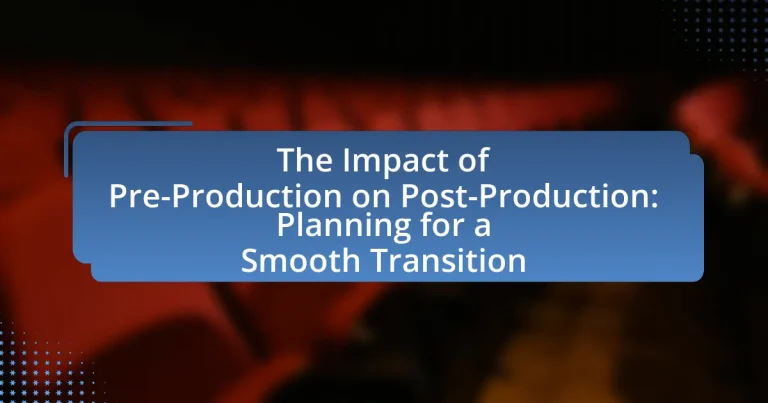The article examines the critical role of pre-production in shaping the outcomes of post-production in film and media projects. It highlights how effective pre-production planning—encompassing script development, casting, scheduling, and budgeting—establishes a clear roadmap that minimizes delays and enhances efficiency during post-production. Key elements such as thorough script development, detailed storyboarding, and effective communication are discussed as vital contributors to a smoother transition from production to post-production. Additionally, the article addresses the risks associated with inadequate pre-production and offers practical strategies for optimizing the impact of pre-production on post-production processes.

What is the Impact of Pre-Production on Post-Production?
Pre-production significantly influences post-production by establishing a clear roadmap for the entire project. Effective pre-production planning, which includes script development, casting, location scouting, and scheduling, ensures that all necessary elements are in place before filming begins. This thorough preparation minimizes delays and complications during post-production, as it allows editors and visual effects teams to work with well-organized footage and a clear vision of the final product. For instance, a study by the Producers Guild of America found that projects with detailed pre-production plans experience up to 30% fewer post-production revisions, highlighting the direct correlation between pre-production diligence and post-production efficiency.
How does pre-production influence the efficiency of post-production?
Pre-production significantly enhances the efficiency of post-production by establishing a clear roadmap for the entire project. This phase involves detailed planning, including script finalization, scheduling, budgeting, and resource allocation, which minimizes uncertainties during filming. For instance, a well-structured shooting schedule allows for timely completion of scenes, reducing the amount of footage that needs to be edited later. Additionally, thorough pre-visualization techniques, such as storyboarding and animatics, provide a visual reference that streamlines the editing process. Studies show that projects with comprehensive pre-production planning can reduce post-production time by up to 30%, as indicated by industry reports from organizations like the Producers Guild of America. Thus, effective pre-production directly correlates with a smoother and more efficient post-production phase.
What specific pre-production activities contribute to smoother post-production?
Thorough script development, detailed storyboarding, and comprehensive scheduling are specific pre-production activities that contribute to smoother post-production. Script development ensures clarity in narrative and dialogue, reducing the need for extensive edits later. Storyboarding visually maps out scenes, allowing for better planning of shots and transitions, which minimizes confusion during editing. Comprehensive scheduling organizes shooting days and resources efficiently, preventing delays and ensuring that all necessary footage is captured, thus streamlining the editing process. These activities collectively enhance communication among the production team and establish a clear vision, leading to a more efficient post-production phase.
How can pre-production planning mitigate common post-production challenges?
Pre-production planning can significantly mitigate common post-production challenges by establishing clear objectives, timelines, and resource allocations. By defining the project scope and creating detailed shot lists, teams can avoid issues such as missing footage or inadequate coverage, which often lead to extended editing times and increased costs. Additionally, thorough pre-production planning facilitates effective communication among crew members, reducing misunderstandings that can result in rework during post-production. For instance, a study by the American Film Institute found that projects with comprehensive pre-production strategies experienced a 30% reduction in post-production delays. This evidence underscores the importance of meticulous planning in ensuring a smoother transition from production to post-production.
Why is pre-production considered crucial for successful post-production?
Pre-production is crucial for successful post-production because it establishes a clear roadmap for the entire project, ensuring that all elements are planned and organized before filming begins. This phase involves detailed script breakdowns, scheduling, budgeting, and resource allocation, which directly influence the efficiency and effectiveness of the post-production process. For instance, a well-structured shooting schedule minimizes the risk of missing critical shots, thereby reducing the need for costly reshoots and extensive editing later. Additionally, thorough pre-production planning allows for better communication among the crew, which streamlines workflows and enhances collaboration during post-production tasks such as editing, sound design, and visual effects.
What are the risks of inadequate pre-production on post-production outcomes?
Inadequate pre-production significantly increases the risks of delays, budget overruns, and compromised quality in post-production outcomes. When pre-production lacks thorough planning, essential elements such as script development, casting, and scheduling may be poorly executed, leading to confusion and inefficiencies during filming. For instance, a study by the Producers Guild of America found that projects with insufficient pre-production planning experienced an average of 30% more delays in post-production phases. Additionally, without clear communication and defined roles established in pre-production, the likelihood of errors and rework in editing and visual effects rises, ultimately affecting the final product’s coherence and quality.
How does effective communication during pre-production affect post-production?
Effective communication during pre-production significantly enhances the efficiency and quality of post-production. Clear dialogue among team members ensures that everyone understands the project’s vision, objectives, and specific roles, which minimizes misunderstandings and errors later in the process. For instance, when directors, producers, and editors share detailed notes and feedback during pre-production, it leads to a more cohesive final product, as all parties are aligned on expectations and creative direction. Studies show that projects with well-defined communication protocols experience up to 30% fewer revisions in post-production, demonstrating the tangible benefits of effective communication in the earlier stages.

What are the Key Elements of Pre-Production that Impact Post-Production?
The key elements of pre-production that impact post-production include script development, scheduling, budgeting, and casting. Script development ensures a clear narrative structure, which facilitates efficient editing and visual storytelling in post-production. Scheduling establishes a timeline for shooting, directly affecting the availability of resources and personnel during post-production. Budgeting determines the financial resources allocated for editing, visual effects, and sound design, influencing the quality of the final product. Casting impacts the performances captured on film, which are crucial for the editing process and overall narrative coherence. Each of these elements plays a vital role in ensuring a seamless transition from production to post-production, ultimately affecting the project’s success.
What role does script development play in the pre-production phase?
Script development is crucial in the pre-production phase as it establishes the foundation for the entire film project. A well-developed script outlines the narrative structure, character arcs, and dialogue, which guides the production team in visualizing and executing the film. This phase involves multiple revisions and feedback loops, ensuring that the story is coherent and engaging, which directly impacts the effectiveness of the film during post-production. For instance, a study by the University of Southern California found that films with thoroughly developed scripts tend to have higher audience ratings and box office success, highlighting the importance of script quality in the overall production process.
How does a well-structured script facilitate post-production processes?
A well-structured script facilitates post-production processes by providing a clear roadmap for editing, sound design, and visual effects. This clarity allows editors to efficiently organize footage according to the script’s narrative structure, ensuring that scenes are assembled in the intended order. Additionally, a detailed script includes specific notes on sound and visual elements, which aids sound designers and visual effects teams in aligning their work with the director’s vision. For instance, a script that specifies particular sound cues or visual transitions enables these teams to execute their tasks with precision, reducing the likelihood of costly revisions later in the process. Thus, a well-structured script not only streamlines the workflow but also enhances the overall quality of the final product.
What are the common script-related issues that arise during post-production?
Common script-related issues that arise during post-production include continuity errors, dialogue inconsistencies, and pacing problems. Continuity errors occur when there are discrepancies in the script that affect the visual flow of the film, such as changes in character appearance or setting that do not match previous scenes. Dialogue inconsistencies can arise when lines are altered during filming, leading to mismatched audio and visual elements in the final cut. Pacing problems often stem from script changes that affect the rhythm of the story, making certain scenes feel rushed or drawn out. These issues can significantly impact the overall coherence and quality of the final product, underscoring the importance of thorough pre-production planning to mitigate such challenges.
How do casting and crew selection affect post-production quality?
Casting and crew selection significantly influence post-production quality by determining the overall performance and technical execution of the film. A well-chosen cast can enhance the emotional depth and authenticity of the narrative, leading to more compelling footage that requires less editing and correction. For instance, actors with strong improvisational skills can deliver unexpected yet fitting performances, reducing the need for extensive reshoots or edits.
Moreover, selecting a skilled crew, including editors, cinematographers, and sound designers, ensures that the technical aspects of the film are executed proficiently. A proficient editor can streamline the editing process, making it more efficient and effective, which directly impacts the final product’s coherence and pacing. Research indicates that films with experienced crews tend to have smoother post-production phases, as they can anticipate challenges and address them proactively, ultimately enhancing the film’s quality.
What are the implications of casting choices on post-production editing?
Casting choices significantly influence post-production editing by determining the availability of footage, the emotional resonance of performances, and the overall narrative coherence. When actors are selected, their unique interpretations and styles can shape how scenes are constructed and edited, impacting pacing and continuity. For instance, if an actor delivers a performance that deviates from the director’s vision, editors may need to spend additional time reworking scenes to maintain narrative flow. Furthermore, the chemistry between cast members can affect the editing process; strong on-screen relationships may require less cutting to achieve emotional impact, while weaker dynamics might necessitate more extensive edits to create believable interactions. Thus, casting decisions directly affect the efficiency and effectiveness of post-production editing, as they dictate the quality and usability of the captured material.
How does crew expertise influence the post-production workflow?
Crew expertise significantly influences the post-production workflow by enhancing efficiency and quality. Experienced crew members possess a deep understanding of technical processes, enabling them to anticipate challenges and streamline tasks such as editing, sound design, and visual effects. For instance, a skilled editor can quickly identify the best takes and create a cohesive narrative, reducing the time spent on revisions. Additionally, crew members with specialized knowledge can implement advanced techniques that improve the overall production value, ensuring that the final product meets industry standards. This expertise ultimately leads to a smoother transition from production to post-production, minimizing delays and maximizing creative output.

How Can Effective Planning in Pre-Production Lead to a Smooth Transition to Post-Production?
Effective planning in pre-production ensures that all aspects of a project are organized and aligned, facilitating a seamless transition to post-production. By establishing clear timelines, budgets, and roles, pre-production minimizes uncertainties and miscommunications that can disrupt the workflow during post-production. For instance, detailed shot lists and storyboards created in pre-production provide a clear roadmap for editors, reducing the time spent on decision-making and revisions. Additionally, thorough preparation allows for the identification and resolution of potential issues before filming begins, which can prevent costly delays and rework in post-production. This structured approach ultimately leads to a more efficient editing process, as all necessary materials are readily available and well-documented.
What strategies can be employed during pre-production to ensure a seamless post-production process?
To ensure a seamless post-production process, comprehensive planning during pre-production is essential. This includes creating a detailed production schedule that outlines every phase of filming, which helps in managing time effectively and avoiding delays. Additionally, thorough script breakdowns allow for identifying all necessary elements, such as locations, props, and special effects, ensuring that nothing is overlooked.
Furthermore, establishing clear communication channels among the crew fosters collaboration and minimizes misunderstandings, which can lead to costly rework in post-production. Utilizing storyboards and shot lists aids in visualizing the project, ensuring that the filming aligns with the intended vision, thus reducing the need for extensive editing later.
Finally, conducting test screenings or reviews of footage during production can provide immediate feedback, allowing for adjustments before the final edit, which streamlines the post-production workflow. These strategies collectively contribute to a more organized and efficient transition from production to post-production.
How can scheduling and budgeting in pre-production impact post-production timelines?
Scheduling and budgeting in pre-production significantly impact post-production timelines by establishing a clear framework for resource allocation and workflow management. Effective scheduling ensures that all necessary elements, such as filming days and location availability, are coordinated, reducing delays that can arise from last-minute changes. A well-defined budget allows for the timely acquisition of essential tools and personnel, preventing bottlenecks during post-production. For instance, a study by the Producers Guild of America found that projects with detailed pre-production plans completed post-production 30% faster than those without. This correlation highlights the importance of thorough pre-production planning in achieving efficient post-production processes.
What tools and technologies can aid in bridging pre-production and post-production?
Project management software, such as Trello or Asana, can effectively bridge pre-production and post-production by facilitating collaboration and tracking progress. These tools allow teams to organize tasks, set deadlines, and communicate efficiently, ensuring that all aspects of production are aligned. Additionally, cloud-based storage solutions like Google Drive or Dropbox enable easy sharing of scripts, storyboards, and footage, allowing for seamless access and collaboration between pre-production and post-production teams. The integration of editing software, such as Adobe Premiere Pro or Final Cut Pro, with project management tools further streamlines the workflow, as it allows for direct feedback and adjustments based on pre-production planning. This interconnected approach enhances productivity and minimizes delays, ultimately leading to a smoother transition between production phases.
What are the best practices for aligning pre-production and post-production teams?
The best practices for aligning pre-production and post-production teams include establishing clear communication channels, defining roles and responsibilities early, and creating a shared project timeline. Clear communication ensures that both teams are on the same page regarding project goals and expectations, which is critical for a smooth transition. Defining roles and responsibilities helps prevent overlap and confusion, allowing each team to focus on their specific tasks. A shared project timeline facilitates coordination and ensures that deadlines are met, which is essential for maintaining workflow efficiency. These practices are supported by industry standards that emphasize the importance of collaboration in film and media production, as effective alignment can significantly reduce delays and improve overall project quality.
How can regular communication between teams enhance the transition from pre-production to post-production?
Regular communication between teams enhances the transition from pre-production to post-production by ensuring alignment on project goals and expectations. This ongoing dialogue facilitates the sharing of critical information, such as timelines, resource allocation, and creative direction, which are essential for a seamless handover. Studies show that projects with effective communication strategies experience up to 30% fewer delays and cost overruns, highlighting the importance of collaboration in maintaining workflow continuity. By addressing potential issues early through regular updates, teams can adapt quickly, reducing the risk of miscommunication and enhancing overall project efficiency.
What role does documentation play in ensuring continuity between pre-production and post-production?
Documentation serves as a critical tool in ensuring continuity between pre-production and post-production by providing a comprehensive record of decisions, plans, and processes. This record includes scripts, storyboards, schedules, and production notes that guide the post-production team in maintaining the original vision and intent of the project. For instance, a well-documented shooting schedule allows editors to align footage with the intended narrative structure, ensuring that the final product reflects the creative direction established during pre-production. Furthermore, documentation facilitates communication among team members, reducing the risk of misunderstandings and errors that could disrupt the workflow. Studies have shown that projects with thorough documentation experience fewer delays and revisions, underscoring the importance of this practice in achieving a seamless transition from pre-production to post-production.
What practical tips can help filmmakers optimize the impact of pre-production on post-production?
Filmmakers can optimize the impact of pre-production on post-production by creating a detailed shooting schedule and maintaining clear communication among the crew. A well-structured shooting schedule allows for efficient time management, reducing the likelihood of delays that can complicate post-production. Clear communication ensures that all team members are aligned on the project’s vision and technical requirements, which minimizes misunderstandings that could lead to additional editing work later. Research indicates that projects with comprehensive pre-production planning experience up to 30% fewer post-production issues, highlighting the importance of these practices in achieving a smoother transition.
How can filmmakers create a checklist for effective pre-production planning?
Filmmakers can create a checklist for effective pre-production planning by identifying key elements such as script finalization, budgeting, scheduling, casting, location scouting, and equipment procurement. Each of these elements should be broken down into specific tasks, ensuring that all necessary steps are accounted for. For instance, script finalization involves securing the final draft and obtaining necessary rights, while budgeting requires detailed cost estimates for each aspect of production. Research indicates that thorough pre-production planning can reduce post-production issues by up to 30%, highlighting the importance of a comprehensive checklist in facilitating a smooth transition from pre-production to post-production.
What common pitfalls should filmmakers avoid during pre-production to enhance post-production outcomes?
Filmmakers should avoid inadequate planning during pre-production to enhance post-production outcomes. Insufficiently detailed shooting schedules can lead to rushed filming, resulting in incomplete or unusable footage. Additionally, neglecting to finalize the script can cause inconsistencies in the narrative, complicating the editing process. Failing to conduct thorough location scouting may result in logistical challenges that disrupt the shooting schedule, further complicating post-production. Moreover, not assembling a skilled crew can lead to poor-quality footage, making editing more difficult. Research indicates that projects with comprehensive pre-production planning experience smoother post-production phases, as evidenced by a study from the University of Southern California, which found that 70% of successful films had detailed pre-production processes.


